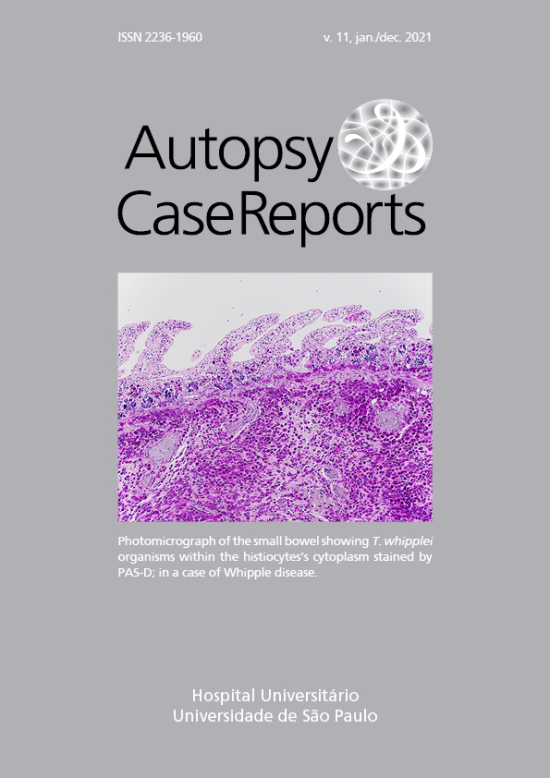Amniotic fluid embolism: lessons for rapid recognition and intervention
DOI:
https://doi.org/10.4322/acr.2021.311Keywords:
Amniotic fluid embolism, Maternal mortality, Autopsy, Extracorporeal membrane oxygenationAbstract
Amniotic fluid embolism is a rare, often fatal complication of labor and delivery. The classic presentation is the sudden onset of a triad of clinical manifestations: hypoxia, hypotension and coagulopathy. Understanding of the syndrome as an immunologically mediated, complicated and often catastrophic maternal response to fetal or placental antigens is coming into focus. New treatments such as extracorporeal membrane oxygenation (ECMO) and better use of old treatments such as transfusion offer hope, but the condition is often rapidly fatal, so saving the maternal and fetal lives depends on rapid recognition of the syndrome. This series of three cases illustrates the clinical features enabling the rapid recognition needed for successful treatment of amniotic fluid embolism syndrome.
Downloads
References
Bernstein SN, Cudemus-Deseda GA, Ortiz VE, Goodman A, Jassar AS. Case 33-2019: a 35-year-old woman with Cardiopulmonary Arrest during Cesarean Section. N Engl J Med. 2019;381(17):1664-73. http://dx.doi.org/10.1056/NEJMcpc1904046. PMid:31644848.
Stafford IA, Moaddab A, Dildy GA, et al. Amniotic fluid embolism syndrome: analysis of the Unites States International Registry. Am J Obstet Gynecol MFM. 2020;2(2):100083. http://dx.doi.org/10.1016/j.ajogmf.2019.100083. PMid:33345954.
Yang R-L, Lang M-Z, Li H, Qiao X-M. Immune storm and coagulation storm in the pathogenesis of amniotic fluid embolism. Eur Rev Med Pharmacol Sci. 2021;25(4):1796-803. PMid:33660788.
Hession PM, Millward CJ, Gottesfeld JE, et al. Amniotic fluid embolism: using the medical staff process to facilitate streamlined care. Perm J. 2016;20(4):15-248. http://dx.doi.org/10.7812/TPP/15-248. PMid:27541321.
Matsunaga S, Masuko H, Takai Y, Kanayama N, Seki H. Fibrinogen may aid in the early differentiation between amniotic fluid embolism and postpartum haemorrhage: a retrospective chart review. Sci Rep. 2021;11(1):8379. http://dx.doi.org/10.1038/s41598-021-87685-y. PMid:33863968.
Fudaba M, Tachibana D, Misugi T, Nakano A, Koyama M. Excessive fibrinolysis detected with thromboelastography in a case of amniotic fluid embolism: fibrinolysis may precede coagulopathy. J Thromb Thrombolysis. 2021;51(3):818-20. http://dx.doi.org/10.1007/s11239-020-02237-x. PMid:32728910.
Williams P, Nguyen J, Duncan ME. Subclinical amniotic fluid embolism presenting as sudden onset seizure activity and reintubation. Am Surg. 2020;86(4):e198-9. http://dx.doi.org/10.1177/000313482008600412. PMid:32391778.
Bouvet L, Gariel C, Charvet A, Boisson-Gaudin C, Chassard D. Contribution of blood detection of insulin-like growth factor binding protein-1 for the diagnosis of amniotic-fluid embolism: a retrospective multicentre cohort study. BJOG. 2021;1471-0528.16672. [Online ahead of print]. http://dx.doi.org/10.1111/1471-0528.16672. PMid:33595867.
Venegas C, Svenningsen S, Kjarsgaard M, et al. Lessons of the month: a breathless severe asthmatic in the genomic era: Occam’s razor or Hickam’s dictum? Clin Med. 2020;20(6):e264-6. http://dx.doi.org/10.7861/clinmed.2020-0661. PMid:33199334.
Durgam S, Sharma M, Dadhwal R, Vakil A, Surani S. The role of extra corporeal membrane oxygenation in amniotic fluid embolism: a case report and literature review. Cureus. 2021;13(2):e13566. PMid:33791181.
Nichols L. Medical education needs typical cases of common diseases. Autops Case Rep. 2019;9(1):e2018080. http://dx.doi.org/10.4322/acr.2018.080. PMid:30881928.
Downloads
Published
Issue
Section
License
Copyright (c) 2021 Autopsy and Case Reports

This work is licensed under a Creative Commons Attribution 4.0 International License.
Copyright
Authors of articles published by Autopsy and Case Report retain the copyright of their work without restrictions, licensing it under the Creative Commons Attribution License - CC-BY, which allows articles to be re-used and re-distributed without restriction, as long as the original work is correctly cited.



